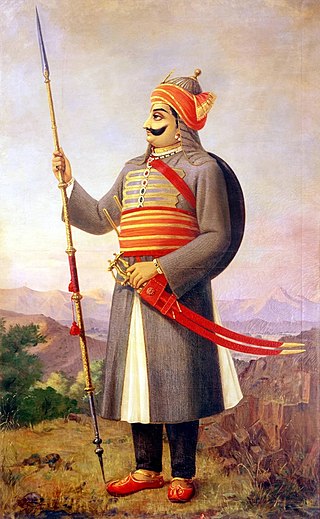
The Rajputana Agency was a political office of the British Indian Empire dealing with a collection of native states in Rajputana, under the political charge of an Agent reporting directly to the Governor-General of India and residing at Mount Abu in the Aravalli Range. The total area of the states falling within the Rajputana Agency was 127,541 square miles (330,330 km2), with eighteen states and two estates or chiefships.

Pratap Singh I, popularly known as Maharana Pratap, was king of the Kingdom of Mewar, in north-western India in the present-day state of Rajasthan, from 1572 until his death in 1597. He is notable for leading the Rajput resistance against the expansionist policy of the Mughal Emperor Akbar including the Battle of Haldighati and the Battle of Dewair.
Shahpura is a city and district headquarter of Shahpura district, in the Indian state of Rajasthan. It was made a district on 17 March 2023.

The Kingdom of Amber, later the Kingdom of Jaipur or the Jaipur State, was located in the north-eastern historic Dhundhar region of Rajputana and was ruled by the Kachwaha Rajput clan. It was established by Dulha Rai, possibly the last ruler of the Kachchhapaghata dynasty of Gwalior who migrated to Dausa and started his kingdom there with the support of Chahamanas of Shakambhari with coalition of Gaur dynasty of sheopur in the 12th century. Mostly through 12th to 15th century, the kingdom faced stagnation, sources were scarce. Under its ruler, Raja Chandrasen of Amber became a Sisodia vassal and fought in the Battle of Khanwa under Raja Prithviraj Kachhwaha.

The Kingdom of Mewar was an independent Hindu kingdom that existed in the Rajputana region of the Indian subcontinent and later became a dominant state in medieval India. The kingdom was initially founded and ruled by the Guhila dynasty followed by the Sisodiya Dynasty. The kingdom came to be known as the Udaipur State after it became a princely state under British suzerainty in the nineteenth century.
Thakur Kesari Singh Barhath was an Indian revolutionary leader, freedom fighter, and educator from the state of Rajasthan. He was the Chief Counselor to Maharana of Mewar. He was the patriarch of the Souda Barhath family, members of which participated in anti-British activities Barhath was also known as Rajasthan Kesari.

Bundi State, founded by Hada Rao Devda, was a princely state in India. The former state was located in modern-day Rajasthan. It was ruled by Hada Chauhan Rajputs.

Kishangarh State was a Princely State in central Rajputana territory of British India from 1611 to 1948. It was founded by the Jodhpur prince Kishan Singh in the year 1611.He was given the land in and around Kishangarh by Mughal Emperor Jahangir owing to his loyal services as well as a close family relationship.

Bikaner State was the Princely State in the north-western most part of the Rajputana province of imperial British India from 1465 to 1947. The founder of the state Rao Bika was a younger son of Rao Jodha ruler of and founder of the city of Jodhpur in Marwar. Rao Bika chose to establish his own kingdom instead of inheriting his father's. Bika defeated the Jat clans of Jangladesh which today refers to the north and north-western Rajasthan along with his uncle Rao Kandhal and his adviser Vikramji Rajpurohit and founded his own kingdom. Its capital was the city of Bikaner.

Pratapgarh State, also known as 'Partabgarh', was one of the princely states of India during the period of the British Raj. The state was founded in 1425 as Kanthal state and was later renamed after its capital located in Pratapgarh, Rajasthan.

Maharana Ari Singh II was the Maharana of the Kingdom of Mewar. His accession to the throne was controversial as he was alleged to have made his way clear and unopposed by killing Kunwar Ratan Singh, the only child of his nephew and predecessor Maharana Raj Singh II.

Maharana Raj Singh I, was the Maharana of Mewar Kingdom and eldest son of Maharana Jagat Singh I. He fought against Mughal Empire and annexed many Mughal territories He participated in Rajput-Mughal War (1679–1707) and defeated the Mughals.
Samthar State was a princely state in India during the British Raj. The state was administered as part of the Bundelkhand Agency of Central India. Its capital was Samshergarh town, located in a level plain in the Bundelkhand region crossed by the Pahuj and the Betwa rivers.

HH Swasti Shri Rajadhiraj Sir Nahar Singh Bahadur was the ruler of Princely State of Shahpura in Rajputana from the year 1870 to 1932.

Mewar Vibhuti, Pradhan Rai Pannalal Mehta (1843–1919) served four Maharanas, as Prime Minister of Mewar state in former state of Rajputana in India.
Zalim Singh (1739-1824), sometimes refer as Zalim Singh Jhala or Zalim Singh of Kotah, a Jhala rajput, was an administrator, reformer and army commander of Kota state. He was the de facto ruler of Kota State from 1771 to until his death in 1824. He was referred to by his contemporary James Tod as the Machiavelli of Rajasthan.
Chetavani ra Chungatya is a patriotic Dingal poem composed by Thakur Kesari Singh Barhath in 1903 and addressed to Maharana of Mewar, Fateh Singh, exhorting him to uphold the traditions of his lineage and to not attend the Delhi Durbar. The couplets had the desired effect on the Maharana who decided not to attend the durbar despite being present in Delhi. The work remains one of the great literary works produced during the freedom struggle. It consists of 13 stanzas or sortha (saurashtra-duha).














